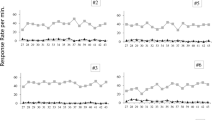Abstract
This experiment investigated use of the resistance to reinforcement procedure to measure the inhibitory properties of a negative discriminative stimulus (S-) following discrimination training. One group of rats initially learned a problem with Cue Light 1 as the positive discriminative stimulus (S + ) and Cue Light 2 as S-; a second group had equal training with house light on as S + and dark as S-. During subsequent testing both groups were reinforced for responding to both dark and Cue Light 2. Thus, inhibitory properties of each S- could be evaluated by both within- and between-subject comparisons, with responding to a novel stimulus as the baseline in both cases. Between- and within-subject comparisons corresponded perfectly with both showing the dark S- to be a strong inhibitor, but neither showing the Cue Light 2 S- to have inhibitory properties. A possible explanation of the latter result is that discrimination learning involves two stages. In the first, excitatory properties of S- are lost, and only then does further training result in the development of true inhibition. The light-dark problem was learned quickly, and training continued well beyond the point where responding to S-was very low. Thus, it is not surprising that strong inhibition was demonstrated. With the more difficult problem, subjects achieved good discrimination performance only near the end of training and responding to S- was still relatively high. Thus, training may not have been sufficient to get beyond the stage of reducing excitation and into the development of true inhibition.
Similar content being viewed by others
References
FARTHING, G.W., & HEARST, E. 1968. Generalization gradients of inhibition after different amounts of training. Journal of the Experimental Analysis of Behavior, 11, 743–752.
FRIEMAN, J., & GOYETTE, C.H. 1973. Transfer of training across stimulus modality and response class. Journal of Experimental Psychology, 97, 235–241.
GUTMAN, A. 1977. Positive contrast, negative induction, and inhibitory stimulus control. Journal of the Experimental Analysis of Behavior, 27, 219–233.
HEARST, E. 1971. Contrast and stimulus generalization following prolonged discrimination training. Journal of the Experimental Analysis of Behavior, 15, 355–363.
HEARST, E., BESLEY, S., & FARTHING, G.W. 1970. Inhibition and the stimulus control of operant behavior. Journal of the Experimental Analysis of Behavior, 14, 373–409.
KARPICKE, J., & HEARST, E. 1975. Inhibitory control and errorless learning. Journal of the Experimental Analysis of Behavior, 23, 159–166.
RESCORLA, R.A. 1969. Pavlovian conditioned inhibition. Psychological Bulletin, 72, 77–94.
RILLING, M. 1977. Stimulus control and inhibitory processes. In W.K. Honig & J.E.R. Staddon (Eds.). Handbook of operant behavior. Englewood Cliffs, New Jersey: Prentice-Hall.
RILLING, M., CAPLAN, H.J., HOWARD, R.C., & BROWN, C.H. 1975. Inhibitory stimulus control following errorless discrimination learning. Journal of the Experimental Analysis of Behavior, 24, 21–133.
SELEKMAN, W. 1973. Behavioral contrast and inhibitory stimulus control as related to extended training. Journal of the Experimental Analysis of Behavior, 20, 245–252.
SKINNER, B.F. 1938. The behavior of organisms. New York: Appleton-Century-Crofts.
TOMIE, A., & KRUSE, J. 1980. Retardation tests of inhibition following discriminative autoshaping. Animal Learning & Behavior, 8, 401–408.
WILLIAMSON, D.A., LEEMING, F.C., SEWELL, W.R., & ROBINSON, K.D. 1979. The detection of inhibition using the resistance to reinforcement method. The Psychological Record, 29, 231–244.
YARCZOWER, M., & CURTO, K. 1972. Stimulus control in pigeons after extended discrimination training. Journal of Comparative and Physiological Psychology, 80, 484–489.
ZENTALL, T., COLLINGS, N., & HEARST, E. 1971. Generalization gradients around a formerly positive S-. Psychonomic Science, 22, 257–259.
Author information
Authors and Affiliations
Rights and permissions
About this article
Cite this article
Leeming, F.C. The Resistance to Reinforcement Technique for Measuring Inhibition. Psychol Rec 32, 435–444 (1982). https://doi.org/10.1007/BF03394800
Published:
Issue Date:
DOI: https://doi.org/10.1007/BF03394800




